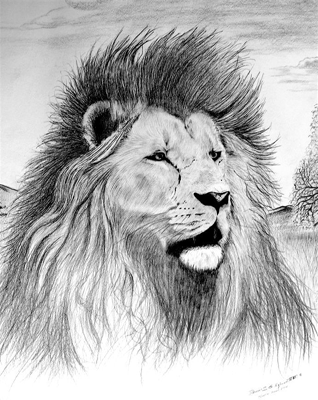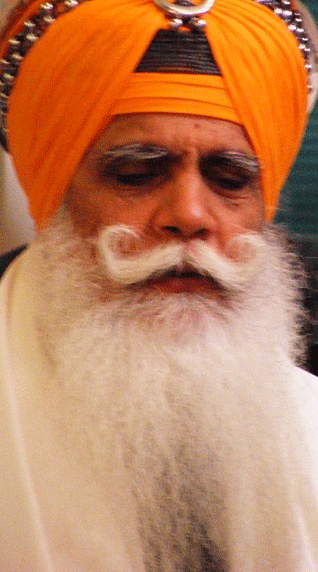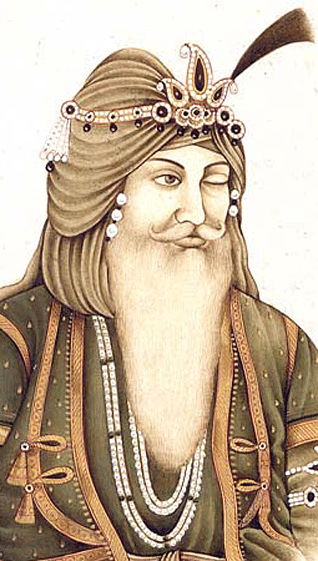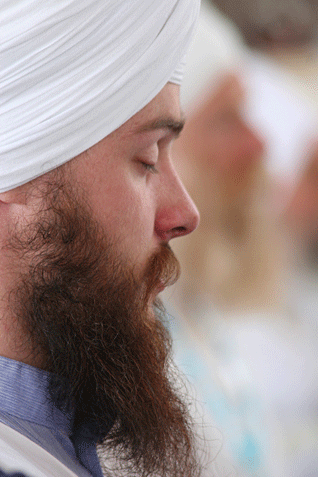
Above: from a painting by Dennis Hepworth. Below: First from bottom: photo of S. Gurujot Singh by Gurumustuk Singh. Second from bottom - Lion of the Punjab, Maharaja Ranjit Singh. Third from bottom - Bhai Hardeep Singh.



Columnists
The Mane of a Lion
by RUBIN PAUL SINGH
While on a road trip this past summer, my seven-year-old niece asked me a question that caught me off guard.
She asked: "Mama ji, why don't you tie your beard?"
To be honest, it wasn't something I had thought much about, so it wasn't easy to come up with a quick answer, let alone one that would satisfy an inquiring seven-year-old.
With little thought, I quickly responded: "Because I want to look like my heroes." She didn't ask any more questions. The answer seemed to satisfy her, but I wasn't sure if it satisfied me; perhaps it needed a little more thought.
Like many young boys born and raised in the U.S., my bedroom reflected all of my interests, and its walls paid homage to many of my heroes.
I was an avid sports fan - so, the likes of Michael Jordan, Walter Payton and John Riggins adorned a wall.
But as the mid-80's approached, my interests shifted. Unrest was growing in Punjab and I became inspired to learn more about my faith and my history.
From the moment I began delving into our rich past, I was captivated! The more I read, the more fascinated I was, not only by the Gurus and their lives, but also by the brave generals who came after the period of the Gurus. They fought intense battles against injustice and for the sovereignty of the Khalsa Panth.
Soon enough, the pictures of my sports heroes came down, and images of Banda Singh Bahadur, Baba Deep Singh, and Maharaja Ranjit Singh made their way onto my walls. My room became a shrine to Sikh leaders and battlefield heroes, like Hari Singh Nalwa, Jassa Singh Ahluwalia, and Akali Phula Singh.
Given the political climate at the time and my study of the Sikh struggle of the 1980's, the likes of modern-day generals such as Baba Jarnail Singh, Bhai Amrik Singh, and General Shubeg Singh made their way to my wall.
As I got older and broadened my learning, pictures of Giani Ditt Singh, Prof. Puran Singh, and Bhai Vir Singh were also proudly displayed. Often times, I would daydream gazing at my wall, and I would think of all that these charismatic leaders, brave soldiers and amazing personalities had in common - their sheer courage, their ability to overcome adversity, their commitment to their faith, and their passion for Sikhi.
But at a quick glance, you would notice the one thing that stood out automatically - they all had long, flowing beards!
Since then, I have found the "khullih-dharrih" look to be both regal and impressive. I know you cannot judge a book by its cover and "baana" alone does not define your character, but at a completely superficial level, I find it beautiful!
The flowing beard is like poetry to me ... or, as I call it, "Floetry."
Perhaps because it reminds me of what my Gurus must have looked like, and of their personality and their character, and their ability to re-mould society.
Whenever I see someone similar at the gurdwara, at a nagar kirtan, in downtown, or at the mall, I feel a connection. I am overwhelmed - and I find a deeper appreciation for my own kakaars.
People may have many theories as to why Guru Sahib gifted this to us, but to me, I believe it is to give me just this feeling and emotion.
I remember years ago, while on a business trip in New Zealand, stopped at a traffic light, I looked over and spotted another driver with a beautiful kesri dastaar and a khullah dharrah! I don't know what came over me - but it brought tears to my eyes. There I was, far from home, far from my sangat - but this image alone, connected me to my Gurus, to my heroes, and to my history.
Although I have chosen to let my beard flow at Sikh functions for years, I finally decided to stop tying it at work, as well.
This may seem like a small deal to most, but regardless of my admiration of the khullih dharrih look, it was still something I was conscious about for myself. But with my wife's encouragement, I was able to "take the plunge" and can say that I've been gel- and hairspray-free for over a year.
Thank God!
It's been an interesting transition. When walking through the mall or in the city, sure, I do get a few extra stares, and maybe a few more ignorant comments than before, but for every negative, I receive just as many positive comments.
Sometimes children will come up to me and tell me they like my beard. Often times the "follicle-challenged" would explain how hard they've tried to grow a beard like mine and failed. And I especially like it when fellow bearded-men smile and nod with a look of camaraderie and brotherhood, as though we are part of some secret society.
It's pretty amusing. I never had these interactions before.
So, when I think back on when my niece asked me why I didn't tie my beard, I wish I could say there was something philosophical or spiritual to it, but the truth is, there isn't. Perhaps it is the kid in me who just wants to look like his heroes, or it is the adult in me who is trying to live up to what his heroes stood for, or maybe just the Sikh in me, who loves his faith, and wants to shout it out from the mountaintop.
January 2, 2009
Conversation about this article
1: I.J. Singh (New York, U.S.A.), January 02, 2009, 3:26 PM.
It is good to be introspective about who we are, what we are and why we are the way we are. A lovely story, nicely and inspiringly told.
2: Harinder (Bangalore, India), January 03, 2009, 7:41 AM.
Be what you want and how you want to look. But don't look down upon other Sikhs who don't sport open beards or somehow fall short of the maryada. For then, though you may look like our ancestors, you are not behaving like them for they did not, I'm sure, pass judgement on others.
3: Kaviraj Singh (U.S.A.), January 03, 2009, 7:55 PM.
Harinder Singh ji, I don't see Rubin Paul Singh at all staring down at anyone who ties his dharrih, or saying that a Sikh should or should not tie his dharrih. All he is saying is that the Gurus and many Sikh heroes left their dharrih khullih and he has decided to do the same. Personally, I commend Rubin for his choice and wish I could do the same.
4: Amarpreet Singh (Malaysia), January 04, 2009, 1:10 AM.
A nice piece of personal article. "Sabat Soorat Rab di ... Bhanne be-imaan ..." We should be proud of what we are. I am in Malaysia and see very very few people wearing nice turban, and never see someone with Khullah Dahrrah..
5: Bhupinder Singh Ghai (New Delhi, India), January 05, 2009, 6:57 AM.
I often wonder how Sikhs came about tying/dressing their beards? I presume it might have carried from the army where soldiers tucked their beards in jaalis (nets). But, I am not sure and would be happy if someone shares some history with us. [Editor: There is some evidence that points to Maharaja Sher Singh, the younger son of Ranjit Singh, as having started the fashion. His contemporaneous portraits also confirm that he indeed was in the habit of dressing his beard by tying it in a knot. The nets and the "army" style would've come much later. But the subject does deserve proper research and begs a dissertation.]
6: Gurmeet Kaur (Atlanta, Georgia, U.S.A.), January 05, 2009, 11:15 AM.
A woman's perspective: a flowing beard adds softness to one's macho looks that a beard normally lends. Combine it with the humility that Sikhi asks for - it represents an ultimate look for a man ... if he has the confidence to carry it. Lovely writing.
7: Sonny (Brooklyn, New York, U.S.A.), January 06, 2009, 12:43 PM.
Thanks so much for this piece. This exact topic has been on my mind a lot the last several months, as I too made the same "transition" to khullih dahrrih this past summer, after gelling, bobby pins, tha-tha-ing, and blow drying for as long as I've had hair on my face. I'm still self-conscious about it sometimes, but it is liberating to have my beard totally natural and unrestricted. I thought about why I was tying it in the first place, and when it came down to it, I couldn't help but feel like I was trying to hide something. And for me, that's not what my Sikh identity is about - quite the contrary, actually. This is not meant to diss anyone who ties or make assumptions about who they are and what they believe, but it's been a personal journey that continues to be really fascinating.
8: Sharan (Los Angeles, California, U.S.A.), January 07, 2009, 1:38 AM.
Awesome writing, Veerji. Very inspiring.
9: Bandana Kaur (New York, U.S.A.), January 07, 2009, 1:54 AM.
Rubin, you're one of my heroes :) Sorry to put you on the spot, brotha, but it's soo true.
10: Gurpreet Singh (Belle Mead, New Jersey, U.S.A.), January 07, 2009, 10:38 AM.
Rubin, it's great to see you join the club. I spoke with Sonny about his journey, and was please to see him don the dharrih with so much pride. I hope that this is a trend that continues with our youth. As you know, the African American population, especially back a few decades ago, used to gel their hair and change their own appearance to make it look as close as possible to that of Caucasian men. Are most of us basically doing something similar? Subconsciously, are we trying to hide our real identities so that we can "fit in", and try to be accepted by the masses? Is tying our beards another form of slavery? Maybe that's a little too extreme. I'm not trying to put down anyone that does tie their beards, especially since many people I look up to still do. Even my parents have tried numerous times to convince me to tie it, possibly for the same subconscious reasons above. But it's something to think about. My experience with the "khullih dharrih' started when I actually first began to tie it for my interviews during junior year in college. It certainly made me feel uncomfortable, as if I had this shell that I was hiding behind (literally, since the hair spray hardened my beard way too much. I couldn't even smile without hearing a crack from the side of my face!), as if I was trying to conceal who I really was. It certainly didn't feel right. Anyway, one day this African American lady from residence life noticed and asked why my beard was tied, and I told her that it may improve my chances for an internshhip. She laughed and said that if the interviewer was going to discriminate against me, if was because I had a beard to begin with, NOT how long it was. Inside, I also laughed at myself for not realizing this. I realized I didn't really have any real reason to tie my beard, especially not for my profession as a consultant. It was nice to feel free again! Anyway, apart from the many deeper reasons to leave the dharrih khullih, one obvious reason is so that you can save hours every day of your life to do something more productive, even if it's to get more sleep!
11: Baaz Singh (Boston, U.S.A.), January 07, 2009, 11:05 AM.
Now, now, let's not get goofy on this. It is wonderful that so many of our young men are opting for khullah dharrahs, and I hope the trend continues to wherever it gets. But for some of you, like Gurpreet Singh above, to start conjecturing on why others tie their beards, or getting into convoluted navel-gazing in cooking-up esoteric reasons for keeping their own beards open, is nothing short of silliness. Get a life, guys. Enjoy what you are, whatever you are, but then, don't - please, please, don't - start pontificating and start pretending that you've just discovered the 'true path' in this one practice. This is the very slippery slope into brahminism and pakhand! Just do what you think is good for you ... and don't bother about passing judgement on others. This "holier than thou" attitude doesn't make you any holier ... all it does is makes you look vacuous and frivolous. But, good piece, Rubin! Keep it up ... and the beard down, of course!
12: Resham Kaur (Nagpur, India), January 07, 2009, 11:13 AM.
Whew! Well said, Baaz Singh! I couldn't have worded it better. And Rubin ... I like your writing. Look forward to more from you.
13: sonny (Brooklyn, New York, U.S.A.), January 07, 2009, 11:19 AM.
I totally agree with you, Gurpreet, and think the parallel to African Americans of all genders sporting afros during the black liberation movement in the U.S. instead of straightening their hair with chemicals as quite a similar and inspiring, cultural movement. I too have been criticised by my family about my khullih dharrih, my parents telling me it doesn't look "professional". Let's think about what that really means. Why should we have to make our beards look shorter in order to be professional? Is this a form of assimilation? The whole point of the very visible articles of faith our Guru gave us is to stand out, and to stand proudly as Sikhs.
14: Satvinder (London, United Kingdom), January 08, 2009, 9:05 AM.
I love the analogy with the lion's mane!
15: Bobby Singh (Birmingham, U.K.), April 08, 2009, 5:55 AM.
A touching article about something that has been on my mind for several weeks. It's nice to read the significance of the beard to a fellow brother. Although I've always had long kesh from birth, I had gone down the path of grooming a trimmed beard for 15 years. It was only in May 08 that Sant Baba Harkowale ji requested that I keep it unshorn on his visit to the U.K. Secretly, this is exactly what I wanted -a 'reason' to keep it. Which I did and have never looked back since. For me, having an open beard is truly a magical experience and provides strength and confidence to my character. I am so proud of it. I do find it difficult to explain and make a non-Sikh understand why it means so much. However, it hasn't been an easy ride, especially as I am currently seeking work in the finance sector and the cold looks received from interviewers are truly astonishing. I have also been challenged by many Western/ European women and given ultimatums. Well, frankly, I feel sorry for the fellow brothers that are easy to push over and not strong willed. It's clear to see why fellow brothers trim their beards in order to fit into society. Well, I say, the challenge is facing these forces of adversity and being proud of the challenge we face in this day and age. It's absolutely minuscule when compared to what our Gurus and martyrs did for the Khalsa Panth and humanity. Let's not forget this! The secret nods of appreciation, the hand shakes and the open happy smiles, are just the small things that make me proud to be a Guru's Singh everyday. Open flowing, healthy, beautiful beards are the way forward. Well written article, Rubin.
16: Navneet Kaur (Fremont, California, U.S.A.), April 27, 2009, 1:55 PM.
I believe one force behind Sikh youth trimming beards or totally removing them are the "Girls" . It's a heart-breaking reality that Sikh girls are choosing boys with no beard or a trimmed one, or even shorn hair with no beard at all. Sikh boys find it more easy to attract a Sikh girl if he has these traits (with no Khulla dhara, where his chances to get a girl for marriage proposal diminishes). I strongly beleive if our Sikh girls start to prefer Sikh boys with beards and turbans, 90% of the sikh youth won't even think of getting it shorned!
17: Darsh (Canada), May 14, 2009, 8:22 PM.
You're the best!
18: Jasjit Singh (United Kingdom), December 07, 2009, 1:22 AM.
It is brilliant to see everyone's views on the topic but as many people above have stated, it is a Sikh's duty to have unshorn hair, facial or on the head. Nowhere does it say whether we are allowed to tie it up or not. However, trimming is a 'no no'. As our sister Navneet Kaur has stated, the reason for the trimming is mainly girls (and the 'kaam' that youths these days have for these so called 'mutiyaaran'). I am a youth too, as I'm only 20 years old, so I know this from what I have experienced around such boys. But I must say, I sometimes gel my beard on the rare occasion that I feel the need (for example, whilst playing rugby), but when my beard is 'khullah', I have had no such problems talking to anyone, or indeed being approached by anyone. It does not inhibit me from interacting, or having (e.g.) lunch with a few female friends of mine (and the area I have lived in all of my life has only two Sikh families, one of which is mine). I find, in these cases, it is best to embrace what God has given us, what the Ten Gurus have fought for, and what our Tenth Master has bestowed upon us: our own identity, the Sikh identity!
19: Jasvir Singh Sidhu (Turlock, California, U.S.A), January 23, 2012, 4:37 PM.
Reading this makes me want to throw away my razor and hair trimmer. Very inspiring story.


